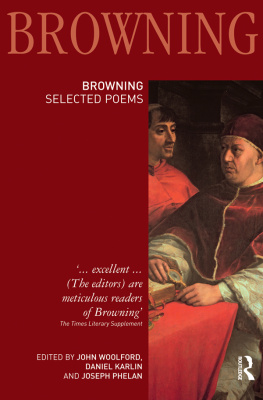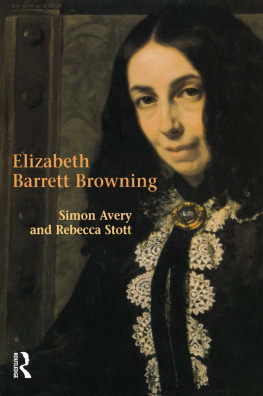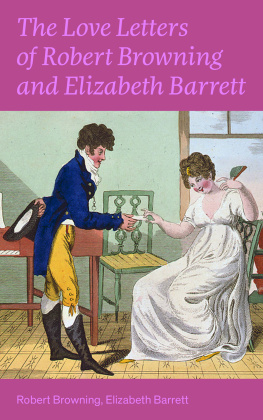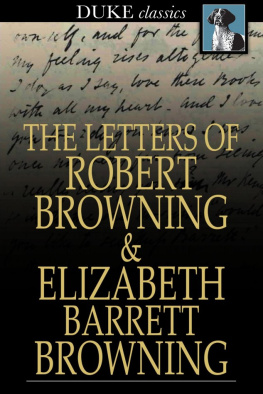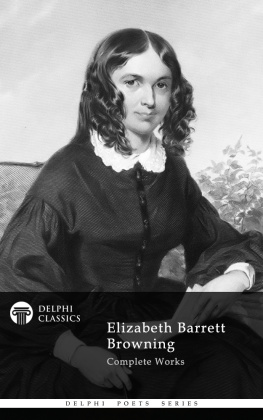Longman Annotated English Poets
LONGMAN ANNOTATED ENGLISH POETS
General Editors: John Barnard and Paul Hammond Founding Editor: F. W. Bateson
Titles available in paperback:
BLAKE: THE COMPLETE POEMS
(Third Edition)
Edited by W. H. Stevenson
DRYDEN: SELECTED POEMS
Edited by Paul Hammond and David Hopkins
THE POEMS OF ANDREW MARVELL
(Revised Edition)
Edited by Nigel Smith
MILTON: PARADISE LOST
(Second Edition)
Edited by Alastair Fowler
MILTON: COMPLETE SHORTER POEMS
(Second Edition)
Edited by John Carey
SPENSER: THE FAERIE QUEENE
(Revised Second Edition)
Edited by A. C. Hamilton
TENNYSON: A SELECTED EDITION
(Revised Edition)
Edited by Christopher Ricks
ROBERT BROWNING: SELECTED POEMS
EDITED BY
John Woolford
Daniel Karlin
Joseph Phelan

First published 2010 by Pearson Education Limited
Published 2013 by Routledge
2 Park Square, Milton Park, Abingdon, Oxon OX14 4RN
711 Third Avenue, New York, NY 10017, USA
Routledge is an imprint of the Taylor & Francis Group, an informa business
Copyright 2010, Taylor & Francis.
All rights reserved. No part of this book may be reprinted or reproduced or utilised in any form or by any electronic, mechanical, or other means, now known or hereafter invented, including photocopying and recording, or in any information storage or retrieval system, without permission in writing from the publishers.
Notices
Knowledge and best practice in this field are constantly changing. As new research and experience broaden our understanding, changes in research methods, professional practices, or medical treatment may become necessary.
Practitioners and researchers must always rely on their own experience and knowledge in evaluating and using any information, methods, compounds, or experiments described herein. In using such information or methods they should be mindful of their own safety and the safety of others, including parties for whom they have a professional responsibility.
To the fullest extent of the law, neither the Publisher nor the authors, contributors, or editors, assume any liability for any injury and/or damage to persons or property as a matter of products liability, negligence or otherwise, or from any use or operation of any methods, products, instructions, or ideas contained in the material herein.
ISBN 13: 978-1-4058-4113-9 (pbk)
British Library Cataloguing in Publication Data
A CIP catalogue record for this book can be obtained from the British Library
Set in 10.5/11.5pt Bembo by 35
Longman Annotated English Poets was launched in 1965 with the publication of Kenneth Allotts edition of The Poems of Matthew Arnold. F. W. Bateson wrote that the new series is the first designed to provide university students and teachers, and the general reader with complete and fully annotated editions of the major English poets. That remains the aim of the series, and Batesons original vision of its policy remains essentially the same. Its concern is primarily with the meaning of the extant texts in their various contexts. The two other main principles of the series were that the text should be modernized and the poems printed as far as possible in the order in which they were composed.
These broad principles still govern the series. Its primary purpose is to provide an annotated text giving the reader any necessary contextual information. However, flexibility in the detailed application has proved necessary in the light of experience and the needs of a particular case (and each poet is, by definition, a particular case).
First, proper glossing of a poets vocabulary has proved essential and not something which can be taken for granted. Second, modernization has presented difficulties, which have been resolved pragmatically, trying to reach a balance between sensitivity to the text in question and attention to the needs of a modern reader. Thus, to modernize Brownings text has a double redundancy: Victorian conventions are very close to modern conventions, and Browning had firm ideas on punctuation. Equally, to impose modern pointing on the ambiguities of Marvell would create a misleading clarity. Third, in the very early days of the series Bateson hoped that editors would be able in many cases to annotate a textus receptus. That has not always been possible, and where no accepted text exists or where the text is controversial, editors have been obliged to go back to the originals and create their own text. The series has taken, and will continue to take, the opportunity not only of providing thorough annotations not available elsewhere, but also of making important scholarly textual contributions where necessary. A case in point is the edition of The Poems of Tennyson by Christopher Ricks, the Second Edition of which (1987) takes into account a full collation of the Trinity College Manuscripts, not previously available for an edition of this kind. Yet the series primary purpose remains annotation.
The requirements of a particular author take precedence over principle. It would make little sense to print Herberts Temple in the order of composition even if it could be established. Where Ricks rightly decided that Tennysons reader needs to be given the circumstances of composition, the attitude to Tennyson and his circle, allusions, and important variants, a necessary consequence was the exclusion of twentieth-century critical responses. Milton, however, is a very different case. John Carey and Alastair Fowler, looking to the needs of their readers, undertook synopses of the main lines of the critical debate over Miltons poetry. Finally, chronological ordering by date of composition will almost always have a greater or lesser degree of speculation or arbitrariness. The evidence is usually partial, and is confused further by the fact that poets do not always write one poem at a time and frequently revise at a later period than that of composition.
John Barnard
Paul Hammond
This selection from the poems of Robert Browning is drawn from the Longman Annotated English Poets edition, of which three volumes have appeared: vol. I (18261840), vol. II (18411846) and vol. III (1847 1861). Errors and misprints have been corrected, and there are some new and revised notes. It also includes some items from the forthcoming vol. IV (18621871). This selection therefore presents work from the period when nearly all of Brownings best-known poetry was published. This introduction draws in part upon the introduction to the first volume of our edition.
I Principles of this Selection
Of Brownings longer single-volume poems we include Pauline (1833) and Pippa Passes (1842). Pauline was his first published poem, and is of interest not only for its curious publication historyit appeared anonymously, only to be immediately withdrawn, reappearing, revised, thirty-five years later in 1868but also for its place in Brownings poetic development. It constitutes a crucial act of poetic self-definition, in which Browning reflects on and transforms his Romantic inheritance. It is thus, in more than one sense, a manifesto, representing the fraught transition from Romantic to Victorian poetics, a process continued, with some popular success, in Paracelsus (1835), but disastrously in Sordello (1840), the most catastrophic poetic failure of the nineteenth century.
Next page
